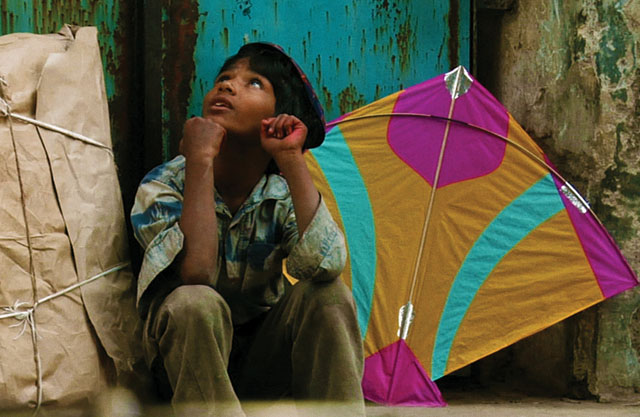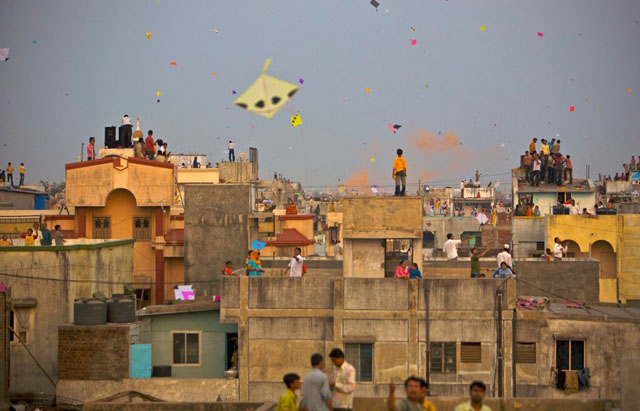CHICAGO – In anticipation of the scariest week of the year, HollywoodChicago.com launches its 2024 Movie Gifts series, which will suggest DVDs and collections for holiday giving.
Interview: Director Prashant Bhargava of ‘Patang’ at Chicago International Film Festival
CHICAGO – Going back to his roots is what director Prashant Bhargava accomplished with his new film “Patang.” The starkly beautiful, highly symbolic film centers on one of India’s largest kite festivals in the old city of Ahmedabad. The film centers on family and the clash of new and old traditions.
Bhargava lives in Chicago, and spent a number of years going back to India to research and do interviews in formulating the film. The simple story of “Patang” is a rich palette of clashing generations, India’s changing moralities and the simplicity of flying kites, which brings all the elements together.
 Photo credit: Kushi Films |
Prashant Bhargava sat down with HollywoodChicago.com for an interview the day after hosting a showing of “Patang” at this year’s Chicago International Film Festival.
HollywoodChicago.com: What did you have to learn about traditional India in order to make the film about the kite festival in Ahmedabad?
Prashant Bhargava: I began seven years ago, with three years of hard research. I would go there, live two months, and then come back to write. I was very conscious that I have to let go of my perspective, and understand the happiness, pride and their history, the people who were in this particular place. I shot 100 hours of research footage, none of which was used in the film. All that footage not only informed what the stories were, but by doing that it developed into the style of the film.
HollywoodChicago.com: How or why did you develop almost an obsession with making sure you were going to get this culture right, and how did that evolve through those 100 hours of footage?
Bhargava: I think ultimately you make a film because there is some sort of self therapy going on. It was the connection to spirit and family, the exuberance that exists in the most simple things in India that I found very interesting. My uncles flew kites when I was a kid, and when they did that they didn’t think about what happened before or afterward, it was just a time to stare up at the sun, and forget about everything. The kite flying holiday is something that goes across all boundaries – Hindu, Muslim, young, old – they are all on the rooftops doing this thing. I thought it was a great metaphor for the character’s lives to parallel, what is happening above.
HollywoodChicago.com: Which character in the film best represents the kite flying, or the freedom of it?
Bhargava: I would say Hamid, the main kid in the film, because his character arc is very small, he doesn’t change much. I saw a kid when I was doing my research, a poor kid, and he was trying to catch a kite when they get cut down. And he ran in front of a bike and it ran into him. This is where you see the class difference in India, the bike rider just picked him up and started slapping him around, just like the film. The kid had a look of hurt and disgust, but then he saw the kite still lying there, and he runs to get it, and everything changes on his face. The film had Hamid delivering kites as part of the journey, and then by the end reaching for a kite, it felt like the spirit of what kite flying is about, and what that city is about.
HollywoodChicago.com: How does the film best celebrate the Indian family and their connections?
Bhargava: The line in the film, ‘we don’t hold onto the past with sadness, we hold onto our little bit of happiness.’ We all have family problems, and no family can resolve their problems in a weekend. But through the aspect of celebrating together, they become a little bit closer. There is strength in accepting who our family is, in order to continue with them.
HollywoodChicago.com: How has the technology of the last 15 years changed the culture of India? We hear lately that they have greatly emerged through the new technological revolution. What have you observed about that?
Bhargava: There are a couple of points, one is that in terms of economy you are seeing a whole new generation of the middle upper class being created. Besides outsourcing, if you go to the campus of “Yahoo!” you’ll find it to be 30% Indian. There is something about us that does that type of logic in a certain way.
Also, when you have the internet and all these technological tools, you have an equalization occur, a culture brought into another era. Things that are created typically through infrastructure or commerce, now can work through the internet and other technologies. The mobile phones there come out much quicker, because there is no notion of a carrier, you can switch whenever you want. They had, for example, phones that shot video much quicker. The society that I loved in Ahmedabad, which isn’t characteristic of other cities, there is a continuation and pride about where they come from, but there is an integration of all the new trends in a way to deepen that.
 Photo credit: Kushi Films |
HollywoodChicago.com: How has the status of women changed in the last two generations in India, and how is that reflected in your film?
Bhargava: The character Priya, who is extremely independent, flirtatious and is obviously someone who has had a lot of experiences in the past, in a way that would have been unsaid earlier. There is no arranged marriages or anything like that. And then there is the character of Sudha, who in a typical way is the emblem of what an Indian woman is supposed to be, the nurturer and the one who holds the house together. So you have these two elements coming together, and they’re having a conversation, and there is the insight of Sudha saying that she didn’t have that freedom growing up, but she wants Priya to have it now.
HollywoodChicago.com: Tell me about the cast, who were the acting veterans, who were the newcomers and how did they help each other?
Bhargava: Sudha, played by Seema Biswas, is one of India’s most renown alternative actresses. She is so insightful toward the process and how she works. Nowaz, who plays Chakku, he’s a guy who is ready to break out. Sugandha Garg, who played the role Priya, is more of a Bollywood personality. She’s played larger parts in Bollywood films. Those were the three actors, everybody else had never been in a film. As a director, my job is to create an environment for them to live on screen, rather than act. I am picking those people to give them the objectives.
HollywoodChicago.com: Your film is dedicated to ‘the parents.’ What has changed the most between the generation before you and the current one, whether you’re talking about Indian culture or the relationship with your parents?
Bhargava: With my parents, their vision of India is what it was 30 years ago. A typical problem in Indian society, both here and there, is the family expectations of what career you choose and when you get married. Many of the films you see of my generation of Indians who grew up in India is about liberation from those parents, and sexual liberation. Those things are a given for me, having grown up in the states, but for them those are the major issues in their life.
HollywoodChicago.com: Finally, what impresses you most about the kite festival and how did you communicate that impression in the film?
Bhargava: It is the mood of universality. Everyone is expressing with passiveness, but within a living heritage. They are pursuing each other, trying to cut each other in kite fights, but the class, religious tensions and all those other things go away.
 | By PATRICK McDONALD |


